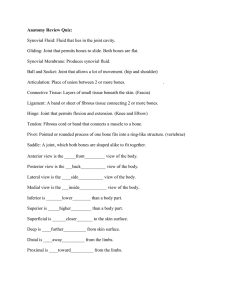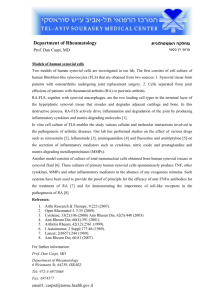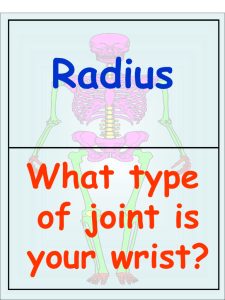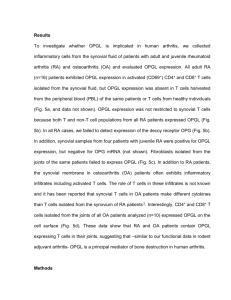The Relationship Between the Molecular Properties and Lubrication
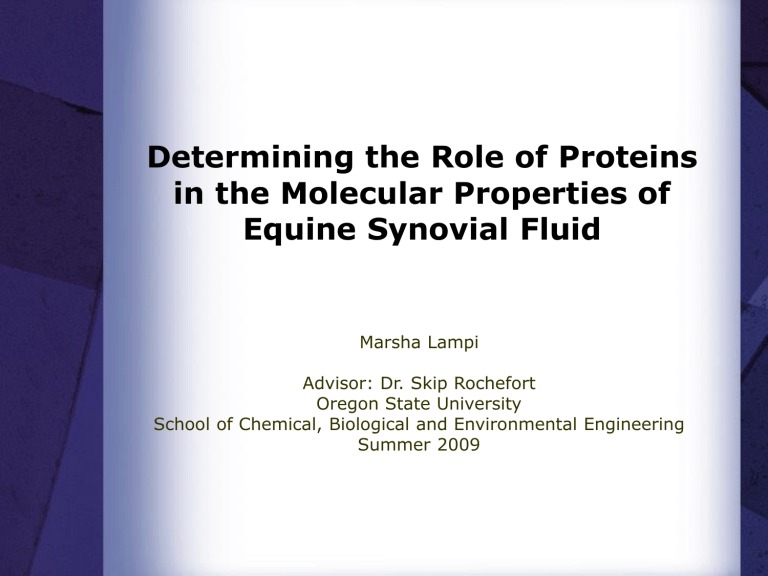
Determining the Role of Proteins in the Molecular Properties of
Equine Synovial Fluid
Marsha Lampi
Advisor: Dr. Skip Rochefort
Oregon State University
School of Chemical, Biological and Environmental Engineering
Summer 2009
Synovial Fluid
Found in diarthrotic, freely moveable joints.
Synovial Joint
Cavity
Responsible for nutrient distribution, lubrication, and shock absorption.
Articular
Cartilage
Articulating
Bone
Used for diagnosis of joint diseases.
Synovial
Membrane http:// edugen.wiley.com/edugen/student/mainfr.uni
Hyaluronic Acid (HA)
Largest molecular component of synovial fluid.
Molecular weight ranges from 0.2 – 10 million g/mol.
Some joint diseases have been linked to the breakdown of HA.
HA injections and oral supplements are currently available and being studied as treatments for joint diseases.
Proteins http://www.scielo.br/img/revistas/bjmbr/v42n4/html/7566i01.htm
Plasma proteins: albumin and globulin
Molecular weight range of 40 – 60 thousand g/mol.
Equine Synovial Fluid http://www.ucmp.berkeley.edu/education/lessons/xenosmilus/skeletal_res_manual2.html
Stifle (knee)
Hock (ankle)
Objective
Develop a protocol to digest the protein in synovial fluid while leaving the hyaluronic acid unchanged.
Methodology
Analyze the molecular composition of synovial fluid with light scattering.
Remove the protein through protease digestion.
Analyze the molecular composition of the digested synovial fluid to verify the protein had been eliminated.
Analysis of
Molecular Composition
Gel Permeation Chromatography
(GPC)
Separates particles based on size.
Small particles get stuck in the packed interior and move through the column slower.
http://www.ap-lab.com/images/LS_setup.gif
http://www.waters.com/waters/partDetail.htm
?locale=en_US&partNumber=WAT045915
Multi-Angle Laser Light Scatter
(MALLS)
Light intensity is measured as a function of the deflection angle and concentration.
Allows for molecular weight determination.
Polymer Solution
Light Source
Detector, I o
Detector, I(
)
Refractive Index (RI) Detector
Determines concentration based on the bending of light in comparison to a reference cell.
http://www.polygen.com.pl/viscotek/refractive_index_detector.html
Experimental Set-Up http://www.ap-lab.com/images/LS_setup.gif
GPC-MALLS Graph
HA Peak
Protein Peak
-Light Scatter
-Refractive Index
Before digestion, both the HA and protein peaks are detected.
Protein Digestion
Protease Bacillus polymyxa, 1.2 U/mg
Preliminary digestion:
− Dilute synovial fluid sample 1:3
− 2 units of protease per mL synovial fluid
− 30 minute incubation in water bath
− Filtration and phenol-chloroform extraction to remove proteins
Kvam, Catrine, Granese Daniela, Flaibani, Antonella, Zanetti, Flavio, and Paoletti, Sergio (1993).
“Purification and Characterization of Hyaluronan form Synovial Fluid”.
Analytical Biochemistry 1993, 211, 44-49.
Undigested Synovial Fluid
-Light Scatter
-Refractive Index
Protein Molecular Weight:
6-8 x 10 4 g/mol
Digested Synovial Fluid
-Light Scatter
-Refractive Index
Protein Molecular Weight:
3-6 x 10 3 g/mol
Protease Concentration
Increase to 4 units/mL Synovial Fluid
-Light Scatter
-Refractive Index
Protein Molecular Weight:
3-6 x 10 3 g/mol
Same elution time = no gain in digestion
Low HA concentration
Removal of Dilution Step
2 units protease/mL Synovial Fluid
-Light Scatter
-Refractive Index
Protein Molecular Weight:
3-6 x 10 3 g/mol
Same elution time = no gain in digestion
Low HA concentration continues. Possibly removed in filtration step.
Removal of Filtration Step
2 units protease/mL Synovial Fluid
-Light Scatter
-Refractive Index
Protein Molecular Weight:
3-6 x 10 3 g/mol
Same elution time = no gain in digestion
Low HA concentration continues. Possibly removed in phenol-chloroform extraction.
Addition of Protease Only
2 units protease/mL Synovial Fluid
-Light Scatter
-Refractive Index
Protein Molecular Weight:
5-7 x 10 4 g/mol
Earlier elution time = Less digestion
There is no change between the digested and undigested samples when treated with the protease.
Conclusion
The protease Bacillus polymyxa currently being used is not effective in digesting the equine synovial fluid proteins. The protein removal may only be due to phenol-chloroform extraction.
Protein digestion always resulted in a reduction of HA. This suggests that there may be an interaction between the proteins and HA in synovial fluid.
Future Work
Test a new protease, either Protease K or Pronase E to digest the protein.
Perform rheological analysis on synovial before and after protein digestion to analyze the effects of the proteins on lubrication and shock absorption.
This would allow us to further determine the interaction between HA and the proteins in synovial fluid.
Acknowledgments
Howard Hughes Medical Institute (HHMI)
URISC
Oregon State University
Dr. Skip Rochefort
Dr. Kevin Ahern
Dr. Jill Parker, OSU School of Veterinary
Medicine
Shannon Cahill-Weisser, Project Assistant
Viscosity
Indication of lubrication capabilities.
Sheer Rate
(Rotation Speed)
Viscosity = Shear Stress
Shear Rate
Sheer Stress
(Torque Measurement)
Elasticity
A measure of shock absorption capabilities
Oscillating cone measures stored energy when fluid compressed.
